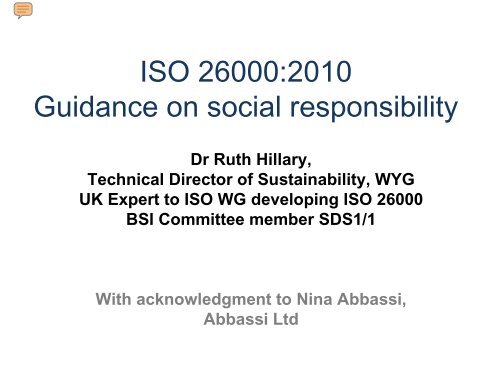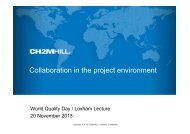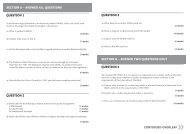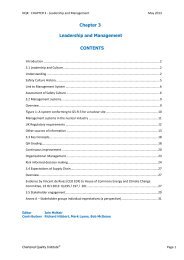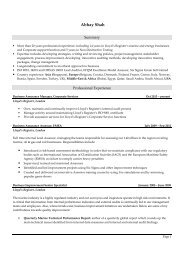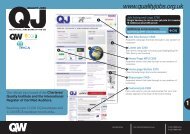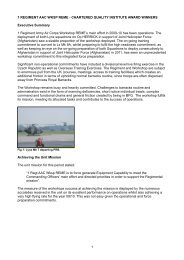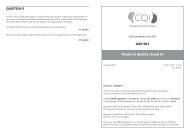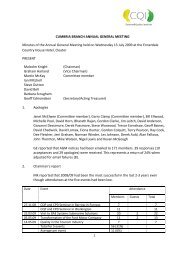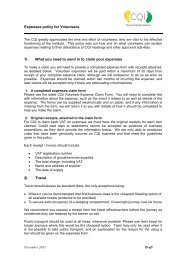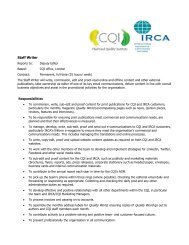ISO 26000:2010 Guidance on social responsibility
ISO 26000:2010 Guidance on social responsibility
ISO 26000:2010 Guidance on social responsibility
Create successful ePaper yourself
Turn your PDF publications into a flip-book with our unique Google optimized e-Paper software.
<str<strong>on</strong>g>ISO</str<strong>on</strong>g> <str<strong>on</strong>g>26000</str<strong>on</strong>g>:<str<strong>on</strong>g>2010</str<strong>on</strong>g><str<strong>on</strong>g>Guidance</str<strong>on</strong>g> <strong>on</strong> <strong>social</strong> resp<strong>on</strong>sibilityDr Ruth Hillary,Technical Director of Sustainability, WYGUK Expert to <str<strong>on</strong>g>ISO</str<strong>on</strong>g> WG developing <str<strong>on</strong>g>ISO</str<strong>on</strong>g> <str<strong>on</strong>g>26000</str<strong>on</strong>g>BSI Committee member SDS1/1With acknowledgment to Nina Abbassi,Abbassi Ltd
Presentati<strong>on</strong> Structure•Development of <str<strong>on</strong>g>ISO</str<strong>on</strong>g> <str<strong>on</strong>g>26000</str<strong>on</strong>g>•Overview of <str<strong>on</strong>g>ISO</str<strong>on</strong>g> <str<strong>on</strong>g>26000</str<strong>on</strong>g>•Benefits and strengths of <str<strong>on</strong>g>ISO</str<strong>on</strong>g><str<strong>on</strong>g>26000</str<strong>on</strong>g>•Future of <str<strong>on</strong>g>ISO</str<strong>on</strong>g> <str<strong>on</strong>g>26000</str<strong>on</strong>g>
Timetable of <str<strong>on</strong>g>ISO</str<strong>on</strong>g> <str<strong>on</strong>g>26000</str<strong>on</strong>g>Committee <strong>on</strong> c<strong>on</strong>sumer policyCOPOLCOresoluti<strong>on</strong><str<strong>on</strong>g>ISO</str<strong>on</strong>g> ApprovalWG SRBrazilMeetingThailandmeetingPortugalMeetingAustraliaMeetingAustriaMeetingChileMeetingQuebecMeetingCopenhagenMeeting<str<strong>on</strong>g>ISO</str<strong>on</strong>g> <str<strong>on</strong>g>26000</str<strong>on</strong>g>issued2002 2003 2004 2005 2006 2007 2008 2009 <str<strong>on</strong>g>2010</str<strong>on</strong>g>
<str<strong>on</strong>g>ISO</str<strong>on</strong>g> Working Group Membership• 450 participating experts & 210 Observers• 99 Countries represented• 42 Liais<strong>on</strong> organisati<strong>on</strong>s• 6 stakeholder groups
A new approach• Joint leadership between Sweden and Brazil• First time that there has been moredeveloping than developed countryinvolvement in standard• MoUs with ILO, UNGC and OECD6
Stakeholder GroupsShowing numbers of experts at Copenhagen Meeting <str<strong>on</strong>g>2010</str<strong>on</strong>g>
C<strong>on</strong>sensus driven
<str<strong>on</strong>g>ISO</str<strong>on</strong>g> <str<strong>on</strong>g>26000</str<strong>on</strong>g> & other standards• <str<strong>on</strong>g>ISO</str<strong>on</strong>g> <str<strong>on</strong>g>26000</str<strong>on</strong>g>:– Refers to other standards– Discusses the relati<strong>on</strong>ship between the standardand the law• <str<strong>on</strong>g>ISO</str<strong>on</strong>g> <str<strong>on</strong>g>26000</str<strong>on</strong>g> is not:– A management system standard (<str<strong>on</strong>g>ISO</str<strong>on</strong>g> 9000 or<str<strong>on</strong>g>ISO</str<strong>on</strong>g> 14001)– A certifiable standard• <str<strong>on</strong>g>ISO</str<strong>on</strong>g> <str<strong>on</strong>g>26000</str<strong>on</strong>g> is a guidance standard
Overview of <str<strong>on</strong>g>ISO</str<strong>on</strong>g> <str<strong>on</strong>g>26000</str<strong>on</strong>g>
Structure of the Standard1. Scope2. Terms and definiti<strong>on</strong>s- 27 Terms3. Understanding <strong>social</strong> resp<strong>on</strong>sibility4. Principles of <strong>social</strong> resp<strong>on</strong>sibility5. Recognizing <strong>social</strong> resp<strong>on</strong>sibility and engagingstakeholders6. <str<strong>on</strong>g>Guidance</str<strong>on</strong>g> <strong>on</strong> <strong>social</strong> resp<strong>on</strong>sibility core subjects7. <str<strong>on</strong>g>Guidance</str<strong>on</strong>g> <strong>on</strong> integrating <strong>social</strong> resp<strong>on</strong>sibility• Annex A – Social Resp<strong>on</strong>sibility Initiatives• Bibliography
SR Definiti<strong>on</strong>Social Resp<strong>on</strong>sibility: resp<strong>on</strong>sibility of anorganizati<strong>on</strong> for the impacts of its decisi<strong>on</strong>s andactivities <strong>on</strong> society and the envir<strong>on</strong>ment,through transparent and ethical behaviour that– c<strong>on</strong>tributes to sustainable development including healthand the welfare of society;– takes into account the expectati<strong>on</strong>s of stakeholders;– is in compliance with applicable law and c<strong>on</strong>sistent withinternati<strong>on</strong>al norms of behaviour; and– is integrated throughout the organizati<strong>on</strong> and practised inits relati<strong>on</strong>shipsNOTE 1 Activities include products, services and processesNOTE 2 Relati<strong>on</strong>ships refer to an organizati<strong>on</strong>’s activities within its sphere ofinfluence
The objective of <strong>social</strong> resp<strong>on</strong>sibility is toc<strong>on</strong>tribute to sustainable development.Sustainable Development : developmentthat meets the needs of the present withoutcompromising the ability of futuregenerati<strong>on</strong>s to meet their own needs."Brundtland report 1987 (Report of the World Commissi<strong>on</strong><strong>on</strong> Envir<strong>on</strong>ment and Development)- same definiti<strong>on</strong> alsoused by <str<strong>on</strong>g>ISO</str<strong>on</strong>g> <str<strong>on</strong>g>26000</str<strong>on</strong>g>:<str<strong>on</strong>g>2010</str<strong>on</strong>g>
The Role of the Principles• 7 principles provide the basis for allorganisati<strong>on</strong>al resp<strong>on</strong>sibility• Each core subject also has principlesassociated with it
The 7 principles• Accountability• Transparency• Ethical behaviour• Respect for the interests of stakeholders• Respect for the rule of law• Respect for internati<strong>on</strong>al norms of behaviour• Respect for human rights16
Role of the principlesAn organisati<strong>on</strong> should be:-• accountable for its impacts <strong>on</strong> society, the ec<strong>on</strong>omyand the envir<strong>on</strong>ment• transparent in its decisi<strong>on</strong>s and activities that impact<strong>on</strong> society and the envir<strong>on</strong>ment• behave ethically• respect, c<strong>on</strong>sider and resp<strong>on</strong>d to the interests of itsstakeholders.• accept that respect for the rule of law is mandatory.• respect internati<strong>on</strong>al norms of behaviour, whileadhering to the principle of respect for the rule of law• respect human rights and recognize both theirimportance and their universality17
Structure of the Standard1. Scope2. Terms and definiti<strong>on</strong>s3. Understanding <strong>social</strong> resp<strong>on</strong>sibility4. Principles of <strong>social</strong> resp<strong>on</strong>sibility5. Recognizing <strong>social</strong> resp<strong>on</strong>sibility and engagingstakeholders6. <str<strong>on</strong>g>Guidance</str<strong>on</strong>g> <strong>on</strong> <strong>social</strong> resp<strong>on</strong>sibility core subjects7. <str<strong>on</strong>g>Guidance</str<strong>on</strong>g> <strong>on</strong> integrating <strong>social</strong> resp<strong>on</strong>sibility• Annex A – Social Resp<strong>on</strong>sibility Initiatives• Bibliography
Recognizing <strong>social</strong> resp<strong>on</strong>sibility andengaging stakeholders• Recognising <strong>social</strong> resp<strong>on</strong>sibilityimpacts, interests and expectati<strong>on</strong>s,recognising the core subjects and issues• Stakeholder identificati<strong>on</strong> and engagement
Structure of the Standard1. Scope2. Terms and definiti<strong>on</strong>s3. Understanding <strong>social</strong> resp<strong>on</strong>sibility4. Principles of <strong>social</strong> resp<strong>on</strong>sibility5. Recognizing <strong>social</strong> resp<strong>on</strong>sibility and engagingstakeholders6. <str<strong>on</strong>g>Guidance</str<strong>on</strong>g> <strong>on</strong> <strong>social</strong> resp<strong>on</strong>sibility core subjects7. <str<strong>on</strong>g>Guidance</str<strong>on</strong>g> <strong>on</strong> integrating <strong>social</strong> resp<strong>on</strong>sibility• Annex A – Social Resp<strong>on</strong>sibility Initiatives• Bibliography
Core Subject Structure1. The Core subject2. Issues for each core subject.For each core subject informati<strong>on</strong> isprovided <strong>on</strong> its scope; descripti<strong>on</strong> of theissue; and related acti<strong>on</strong>s andexpectati<strong>on</strong>s.
e.g. Core subject: The envir<strong>on</strong>mentIssue 1: Preventi<strong>on</strong> of polluti<strong>on</strong>An organizati<strong>on</strong> can improve its envir<strong>on</strong>mentalperformance by preventing polluti<strong>on</strong>, including:– Emissi<strong>on</strong>s to air– Discharges to water– ….To improve the preventi<strong>on</strong> of polluti<strong>on</strong> from itsactivities, an organizati<strong>on</strong> should:– identify the aspects and impacts of itsdecisi<strong>on</strong>s and activities <strong>on</strong> the surroundingenvir<strong>on</strong>ment– …..
Integrating <str<strong>on</strong>g>ISO</str<strong>on</strong>g> <str<strong>on</strong>g>26000</str<strong>on</strong>g>
Structure of the Standard1. Scope2. Terms and definiti<strong>on</strong>s3. Understanding <strong>social</strong> resp<strong>on</strong>sibility4. Principles of <strong>social</strong> resp<strong>on</strong>sibility5. Recognizing <strong>social</strong> resp<strong>on</strong>sibility and engagingstakeholders6. <str<strong>on</strong>g>Guidance</str<strong>on</strong>g> <strong>on</strong> <strong>social</strong> resp<strong>on</strong>sibility core subjects7. <str<strong>on</strong>g>Guidance</str<strong>on</strong>g> <strong>on</strong> integrating <strong>social</strong> resp<strong>on</strong>sibility• Annex A – Social Resp<strong>on</strong>sibility Initiatives• Bibliography
Approaches• Investigate appropriateness– Understanding the organisati<strong>on</strong>– Understand the organisati<strong>on</strong>’s c<strong>on</strong>text• C<strong>on</strong>duct due diligence• Determine relevance & significance• Assess and exercise sphere of influence• Establish priorities for addressing the coreissues
Practices• Internal capacity building- raisingawareness and building competence• ‘setting the directi<strong>on</strong>’• Systems & procedures- Governence• Communicati<strong>on</strong>• Credibility of communicati<strong>on</strong>• M<strong>on</strong>itoring and review• Initiatives (the Appendix)
Challenges1. Assessing sphere of influence2. Establish prioritieso Practical implicati<strong>on</strong>s – of impact, resources,timing, etc
Benefits and Strengths of<str<strong>on</strong>g>ISO</str<strong>on</strong>g> <str<strong>on</strong>g>26000</str<strong>on</strong>g>
Benefits of <str<strong>on</strong>g>ISO</str<strong>on</strong>g> <str<strong>on</strong>g>26000</str<strong>on</strong>g>• Brings existing work <strong>on</strong> <strong>social</strong> resp<strong>on</strong>sibility together –provides a <strong>on</strong>e stop shop reference/resource for studentsand newcomers to SR• Creates an opportunity to extend the understanding andimplementati<strong>on</strong> of SR by:– Helping to develop internati<strong>on</strong>al c<strong>on</strong>sensus <strong>on</strong> what SRmeans and the SR issues that organisati<strong>on</strong>s need toaddress– Providing guidance to help translate SR principles intoacti<strong>on</strong>– Highlighting best practices that have evolved anddisseminating the informati<strong>on</strong> worldwide.30
<str<strong>on</strong>g>ISO</str<strong>on</strong>g> <str<strong>on</strong>g>26000</str<strong>on</strong>g> – Key Strengths• It focuses <strong>on</strong> “taking resp<strong>on</strong>sibility” for the impacts of anorganizati<strong>on</strong>'s decisi<strong>on</strong>s and activities• It can be applied to private and public sector organizati<strong>on</strong>sof any size in any sector• It translates principles into effective acti<strong>on</strong>s at the strategicand operati<strong>on</strong>al levels• It extends the understanding of Organizati<strong>on</strong>alResp<strong>on</strong>sibility by guiding organizati<strong>on</strong>s through the fullrange of issues/acti<strong>on</strong>s they need to c<strong>on</strong>sider• It is not a certifiable standard – it is a guidance framework• It is internati<strong>on</strong>ally recognized and supported31
The Future of <str<strong>on</strong>g>ISO</str<strong>on</strong>g> <str<strong>on</strong>g>26000</str<strong>on</strong>g>• Adopti<strong>on</strong>• Certificati<strong>on</strong>• Review and update
Further informati<strong>on</strong>:http://www.iso.org/iso/iso_catalogue/management_and_leadership_standards/<strong>social</strong>_resp<strong>on</strong>sibility/sr_iso<str<strong>on</strong>g>26000</str<strong>on</strong>g>_overview.htm


